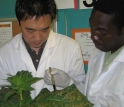News Release 07-134
Scientists to Sick Plants: Take Two Doses of an Aspirin-Like Hormone and Call Me in the Morning
Discovery could lead to development of crops with enhanced yield, heightened immunity and reduced need for pesticides

The illustration depicts steps involved in the development of a systemic immune response in plants.
October 5, 2007
This material is available primarily for archival purposes. Telephone numbers or other contact information may be out of date; please see current contact information at media contacts.
Scientists have finally identified a key component in the disease-fighting process in plants that activates plant-wide defenses after a pathogen attack.
It has long been known that plants often develop a state of heightened resistance, called systemic acquired resistance, following pathogen infection; this phenomenon requires the movement of a signal from the infected leaf to uninfected parts of the plant. Until now, however, no one knew what that signal was.
Now, researchers at the Boyce Thompson Institute for Plant Research (BTI) have identified methyl salicylate (MeSA), an aspirin-like compound, as a signal that alerts a plant's immune system to shift into high gear. This research, which was funded by the National Science Foundation (NSF), is published in the Oct. 5, 2007, issue of Science.
"Now that we have identified a signal that activates defenses throughout the plant, as well as the enzymes that regulate the level of this signal, we may be able to use genetic engineering to optimize a plant's ability to turn on those defenses," said Daniel F. Klessig of BTI, who heads the research team. "This approach could boost crop production and reduce the use of pesticides, which are potentially harmful to people and/or the environment."
Previous studies conducted by the BTI researchers and others had revealed that after a plant is attacked by a pathogen, it produces a disease-fighting hormone called salicylic acid (SA) at the infection site. Some of this SA activates defenses locally, and some of this SA is converted to MeSA, which is biologically inactive since it cannot induce immune responses.
The BTI researchers' most recent study builds on their previous studies by showing that the MeSA produced at an infection sites plays a critical role in the plant's development of systemic acquired resistance. According to this study, MeSA flows from the infection site through the plant's food-conducting tubes (or phloem) to uninfected tissue. Once the MeSA reaches this uninfected tissue, an enzyme known as salicylic acid-binding protein 2 (SABP2) converts the MeSA back into SA. Through this mechanism, "SA is distributed all over the plant, and thereby induces a plant-wide defense response," said Klessig.
The BTI team's conclusions are based on analyses of plants in which SABP2 function was normal, silenced or mutated in different parts/tissues of the plant. These analyses identified the following steps, which also are shown in the figure, for the development of systemic acquired resistance:
- After a plant is infected with a pathogen, SA is produced at the infection site. Some of this SA is converted into MeSA by an enzyme called SA methyl transferase (SAMT). At the same time, some SA present at the infection site binds with SABP2. Because this binding inactivates SABP2, SABP2 doesn't convert accumulating MeSA back into SA as it does elsewhere in the plant. Therefore, MeSA accumulates at the infection site.
- Accumulated MeSA travels from the infection site to distant, uninfected leaves. Klessig said that it is still unclear why plants send an inactive messenger in the form of MeSA to uninfected tissue where it must be reactivated.
- MeSA arriving at distant, uninfected leaves is converted by the active form of SABP2 into disease-fighting SA, which turns on the plant's defenses.
In addition to improving our understanding of systemic acquired resistance, "this research provides insights into how a hormone like SA can actively regulate its own structure--and thereby determine its own activity--by controlling the responsible enzyme," noted Sang-Wook Park, the study's lead author.
Michael Mishkind, an NSF program director, says that "the discovery that MeSA is a mobile signal for systemic acquired resistance solves a major, long-standing problem, provides novel strategies for crop improvement and raises new fundamental questions likely to generate important insights into the immune system of plants."
-NSF-
-
Researchers Dan Klessig, Sang-Wook Park and Evans Kaimoyo with an infected tobacco plant.
Credit and Larger Version
Media Contacts
Lily Whiteman, National Science Foundation, (703) 292-8310, email: lwhitema@nsf.gov
Joanna Cummings, Boyce Thompson Institute for Plant Research, (607) 254-8531, email: jcc328@cornell.edu
Program Contacts
Michael Mishkind, National Science Foundation, (703) 292-8413, email: mmishkin@nsf.gov
Co-Investigators
Daniel Klessig, Boyce Thompson Institute for Plant Research, (607) 254-4560, email: dfk8@cornell.edu
The U.S. National Science Foundation propels the nation forward by advancing fundamental research in all fields of science and engineering. NSF supports research and people by providing facilities, instruments and funding to support their ingenuity and sustain the U.S. as a global leader in research and innovation. With a fiscal year 2023 budget of $9.5 billion, NSF funds reach all 50 states through grants to nearly 2,000 colleges, universities and institutions. Each year, NSF receives more than 40,000 competitive proposals and makes about 11,000 new awards. Those awards include support for cooperative research with industry, Arctic and Antarctic research and operations, and U.S. participation in international scientific efforts.
Connect with us online
NSF website: nsf.gov
NSF News: nsf.gov/news
For News Media: nsf.gov/news/newsroom
Statistics: nsf.gov/statistics/
Awards database: nsf.gov/awardsearch/
Follow us on social
Twitter: twitter.com/NSF
Facebook: facebook.com/US.NSF
Instagram: instagram.com/nsfgov

